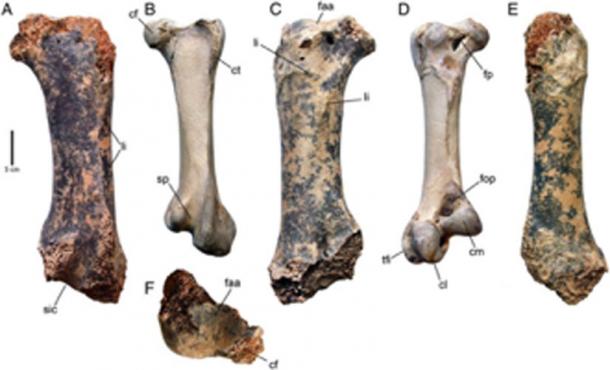
First Giant Bird Found In Europe Lived Alongside Early Humans
Experts in Crimea have found a fossil of a gigantic bird, that lived some 1.6 to 1.8 million years ago. The find demonstrates that giant birds once made their home in Europe and reveals for the first time that they lived north of the equator. It is also allowing experts to better understand the environment in which early humans lived, on the European continent.
The find was made by researchers from the Russian Academy of Sciences. They discovered the fossil at “Taurida Cave on the northern coast of the Black Sea” according to CNN. They had been alerted to the site after it had been discovered by chance during work on extending a freeway in the area. A preliminary excavation of the site resulted in a number of fossils being unearthed, including some from relatives of the mammoth and extinct bison.

Map showing the geographical location of the fossil locality and the cave plan. (Lopatin / Journal of Vertebrate Paleontology)
A Giant Bird in Prehistoric Europe
Next they came across a very unusual fossil of a very large femur, 15 inches long (45 centimeters) long. The Smithsonian.com quotes Nikita Zelenkov a paleontologist, who led the team that studied the bone, “This was the most surprising part for me, such an incredible size, we did not expect that”. Zelenkov and his colleagues soon established that it belonged to a new species of giant bird, which they have called provisionally Pachystruthio dmanisensis.

The femurs of Pachystruthio dmanisensis, an extinct giant bird (panels A, C, E, F), and a modern common ostrich (Struthio camelus) (panels B, D). (Zelenkov / Journal of Vertebrate Paleontology)
They had apparently discovered the first evidence of the existence of a huge bird that lived in Europe. Nova reports that based on “the bone’s dimensions, the researchers estimated the bird’s body mass to be around half a ton”.
This means it may have been the biggest bird ever to have lived in the Northern Hemisphere and the “the third largest bird ever recorded” according to the Smithsonian.com. It was possible to date it to between 1.5 and 1.9 million years ago based on the other fossils found in its vicinity.
The species of avian was very tall about 12 feet (4 meters) high and was a herbivore. The bird was too big to fly, but based on the slender femur, somewhat reminiscent of a huge ostrich it was able to run at considerable speeds, at least briefly. This possibly allowed it to live in the harsh environment of the time. Its ability to run fast meant that it could out-run the ferocious Pleistocene predators such as “giant cheetahs, hyenas, and saber-toothed cats” according to Nova.

The giant bird could run at considerable speeds to escape predators such as the sabre-toothed tiger. (FunkMonk / Public Domain)
A New View of the Ancient Environment
The fossil is challenging the viewpoint that giant birds were not part of the European environment in the distant past. These giants may have grown to such huge sizes because they had to adapt to increasingly arid conditions. Its bulk would have allowed it to digest tough plants that were low in nutrition, that grew in the dry environment.
The dating of the bird means that they may have lived at the same time that the first humans (Homo erectus) arrived in Europe. They migrated to the continent from the Middle East via the Caucasus region, probably the same route was taken by the giant avian species. This scenario raises important questions for researchers, especially with regard as to how they became extinct.
The Giant Bird Was Hunted by Early Humans
The arrival of early humans may have meant that the towering birds had to contend with another predator. H. erectus may have been attracted to the meat and the feathers of Pachystruthio dmanisensis. It is possible that the first humans in Europe exterminated the species. Just as the giant bird, the moa, was hunted to extinction by the Maori in New Zealand. To prove this theory some bones of the towering fowl with cut or burn marks may provide proof it was hunted by early humans.
- 2,000-Year-Old Toddler Skeleton with Elongated Skull Unearthed in Crimea
- Did Humans Speak Through Cave Art? Ancient Drawings and Language's Origins
- First humans in Florida lived alongside giant animals

Homo erectus may have hunted the giant birds. (Tim Evanson / CC BY-SA 2.0)
While it is entirely possible that the species became extinct because of human predation, there may have been other factors that led to its demise and disappearance. Nova, quotes Zelenkov, as stating that possible reasons for the extinction of the bird were “a combination of pressures from a changing climate, predation, and disease”.
The fossil will be compared to a similar bone found in the Republic of Georgia, in order to learn more about the giant avian. It was a very complex creature and it can help us to understand the environment of the Pleistocene. This, in turn, can help us to comprehend the world in which early humans lived in Europe. The question as to whether H. erectus drove the huge birds to extinction is one that needs further study. The research and its conclusions are published in the Journal of Vertebrate Paleontology.
Top image: Pachystruthio dmanisensis, new species of giant bird has been discovered. Source: nicolasprimola / Adobe Stock.
By Ed Whelan
















Comments
So there were Wolly Mamouths and Big Birds hanging around in Eastern Europe with prehistoric man? Sesame Street meets the Flintsones.